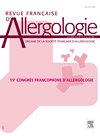Intérêt des patch tests dans l’exploration des réactions d’hypersensibilité retardée aux antiépileptiques
IF 0.3
4区 医学
引用次数: 0
Abstract
Objective
The aim of our study was to evaluate the utility of the patch-tests for the diagnosis of the delayed hypersensitivity reactions induced by antiepileptic drugs and to explore cross-reactivity between them.
Patients and methods
We included cases of delayed drug addiction to antiepileptics notified to the Sfax regional pharmacovigilance center during the period from January 2019 to June 2023. We used the French Bégaud method for the study of imputability. Patch testing was performed in all patients according to the recommendations of the European Network of Drug Allergy. The interpretation of the results was made according to the rules of the International Contact Dermatitis Research Group.
Results
We included 17 delayed drug reactions: Drug Rash with Eosinophilia and Systemic Symptoms (DRESS) syndrome (n = 10), maculopapular rash (n = 6), Stevens-Johnson syndrome (n = 1). Patch tests were positive in 76.47% of cases: 66.66% for maculopapular rash with cross-reactivity between carbamazepine and phenobarbital (n = 1) and 90% in DRESS syndrome with cross-reactivity between 2 or more antiepileptics (n = 5). For the patient with Stevens-Johnson syndrome, the tests were interpreted as irritating.
Conclusion
Patch tests are safe and useful to confirm the imputability of antiepileptic drugs in the genesis of delayed drug hypersensibility reaction and to detect possible cross-reactivity.
贴片测试在探索抗癫痫药物延迟过敏反应中的重要性
目的评价贴片试验对抗癫痫药物致迟发性超敏反应的诊断价值,探讨两者间的交叉反应性。患者和方法纳入2019年1月至2023年6月期间向Sfax地区药物警戒中心报告的抗癫痫药物延迟药物成瘾病例。我们用法国的bsamgaud方法来研究归咎性。根据欧洲药物过敏网络的建议,对所有患者进行了斑贴试验。根据国际接触性皮炎研究小组的规则对结果进行解释。结果纳入17例迟发性药物反应:伴嗜酸性粒细胞增多及全身症状的药物性皮疹(DRESS)综合征(n = 10)、黄斑丘疹(n = 6)、Stevens-Johnson综合征(n = 1)。斑贴试验阳性的病例占76.47%:卡马西平与苯巴比妥交叉反应的黄斑丘疹病例占66.66% (n = 1), DRESS综合征病例占90% (n = 5), 2种及以上抗癫痫药物交叉反应(n = 5)。对于史蒂文斯-约翰逊综合征患者来说,这些测试被认为是刺激的。结论斑贴试验可安全、有效地确定抗癫痫药物在迟发性药物超敏反应发生中的归责关系,并可检测可能的交叉反应。
本文章由计算机程序翻译,如有差异,请以英文原文为准。
求助全文
约1分钟内获得全文
求助全文
来源期刊

Revue Francaise d Allergologie
Medicine-Immunology and Allergy
自引率
33.30%
发文量
349
期刊介绍:
La Revue Française d''Allergologie : un véritable forum pour faire connaître des travaux originaux et permettre la diffusion de l''information auprès de toutes les spécialités concernées par les pathologies allergiques. La Revue Française d''Allergologie (8 numéros par an) est au carrefour de nombreuses spécialités - dermatologie, pédiatrie, ORL, pneumologie, ophtalmologie, médecine interne - qui, toutes, ont à traiter des maladies allergiques. Les symptômes des allergies fondés sur des mécanismes communs sont le plus souvent associés et se succèdent chez un même patient. En forte progression depuis 20 ans, les maladies allergiques sont dans l''attente de perfectionnements et d''avancées thérapeutiques qui permettront aux nombreux patients qui en sont atteints de mieux vivre avec leurs allergies. La Revue Française d''Allergologie se veut donc un véritable forum de discussions et d''échanges entre tous les spécialistes confrontés aux pathologies
 求助内容:
求助内容: 应助结果提醒方式:
应助结果提醒方式:


